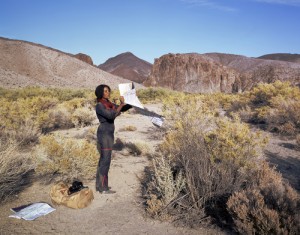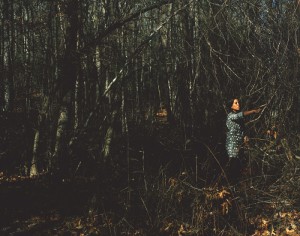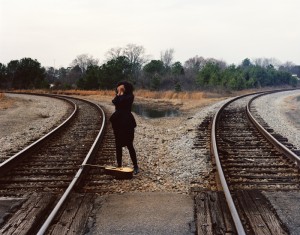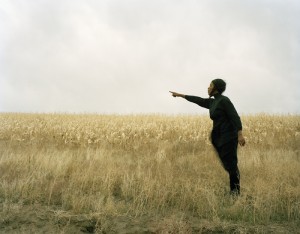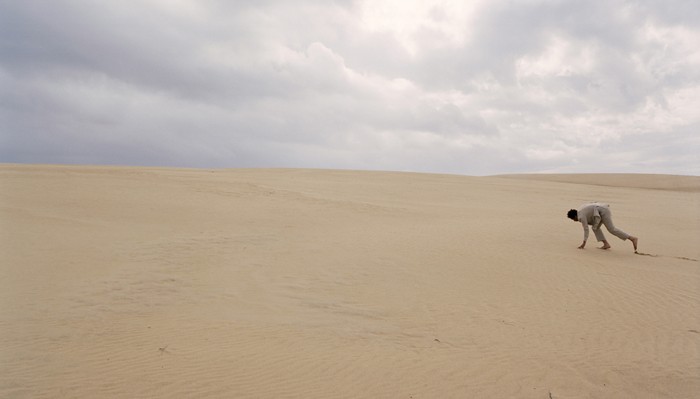
Xaviera Simmons and Cara Despain in Conversation by Cara Despain
Xaviera Simmons’ work is an open read of simultaneous histories embedded in different landscapes that are often presented as layered characters, texts, or moods. I was interested in the way her perspective might fit into this journal, as she constructs and utilizes landscape as well as its social dimensions to create her own topographies. We spoke on the telephone about this idea in reference to this Journal. She has included the script for her performance “Score Number 10”, as well as some stills from the documentation. This is an excerpt from our conversation.
Xaviera Simmons: I really wanted to make a piece that was about the lighting. As with the text, it’s really constructing the feeling of a space, this mood of a space. Almost like a film, but with all of the elements taken away so all you get is the voice and the light. The performance works in moments between dawn, midday, dusk and night. All of my text pieces, whether they are performed or sculptural, think a lot about photography- how photography constructs the landscape and how photography constructs the space, and also how film can construct the space. Those are all visual elements, but this is trying to use the language in visual form to construct the space. Also in the performance, it’s the language along with the lighting. It was about the cinematic quality of the light combined with the text and mood.
In my photographs I’ve always talked about what’s underneath landscape: what histories, multiple histories, layers, and migratory stories. Each centimeter of earth is much like a narrative that you can unfold. And I’m just at the beginning. Even though I’ve been working for a long time, I feel like I’m just at the beginning of bringing together all of these narratives, and how these landscapes and histories can meld together to either: a. bring a nostalgic view of landscape; or b. bring a presence of future feeling of landscape and what’s underneath. There’s different ways to look at landscape. I think I’ve spent a lot of time looking at the sublime, and at the characters I feel are missing in the history of that particular genre. Also, in works like “Superunknown (Alive In The)”, which is not land, it’s sea, but the sea is tied obviously to land. It’s these migrants in between spaces. As far as the piece that I just gave you, “Score Number 10”, I feel like it’s using the same ideas. Excavating text, using texts, films, articles, conversations, poems, to bring forth another landscape or another feeling of place or a multi-layered experience of place in each of those either text works or performance-based works.
I can’t see landscape in a specific, singularly cultural sense. It has to feel as if it is multi-layered. Like you were saying about David Brooks, if you think of a rock—one tree or a rock—there’s so many different layers of history in the one sediment, or in that one piece, or in that sample. I feel similarly with each individual portion of landscape or space. There’s a multitude of histories that you can combine to construct new characters, or new ways of looking at each parcel or space. Even the word “landscape”—thinking about landscape in a wider open field than just the land itself. Thinking of it also as a construction of vastness, or utopia, or man-made destruction. There are so many various layers to thinking about it.
There’s a piece that I produced called “Ideal” at the Studio Museum when I was in residence there. I looked at the word “Afghanistan”. I just started thinking about this word, and then I started thinking about the Middle East—so both of those territories. What are the first top-level images that we think about? I had carpets, and then I had camels, and then somehow I jumped from carpets and camels to deserts, and then manmade topographies- manmade interventions in landscape, but on a grand scale, like oil drilling or diamond mining. Looking at them from an aerial view, you wipe away this oppressive history or current oppression and you just see them for this beautiful aerial view, these fissures in the ground. I think my idea of landscape is always one of the overarching themes of my work, besides the cyclical notion of working on one kind of artwork and switching to the next, there’s always this constant use of landscape in different ways.
I think that piece goes back to “Superunknown”, which looks at migrants in the act of migration, as well as to a piece called “Gain”, which is of animals mid-kill. It is also a predecessor to a piece that’s about Jamaican daggering, which actually was originally looking at these Jamaican bodies in landscape, and how they mimic the landscape of the spaces that they inhabit. I am also considering the construction, how the architecture in Jamaica for me has a little bit of conversation with this contemporary sexualized dance movement. I’m really interested in those bodies now in relationship to landscapes in the States. I’m actually looking at those bodies and their contortions, and then landscapes here in the States.
Cara Despain: I guess when I was saying culture I was more meaning part of the human history that is superimposed on landscape that encompasses and includes all of the things you just described. Even the sublime, or even calling something a landscape and thinking of it as a picture is a human construct that has to be interrupted if we’re making art. I think that’s really interesting, because yours provides this really great, really, really rich kind of metaphorical and poetic look at it. So then when we say topography in regards to what you’re working with, it can also be meant as an amalgamation of layers on top of one another on top of a landscape.
XS: I think that’s a good way to describe how I see it: is an amalgamation of layers, and how to use and combine those layers in different ways. It is also layers of space, and then layers of psychology. And then with psychology you think about emotions. I think layers are a good way to look at it, but with intention. With any work that I’m building—whether it’s a character in a landscape, or if it’s a text piece, or if it’s a performance—it’s all with the intention to build a feeling or a landscape or a narrative in those pieces. It’s not a random layering, it’s an intentional layering so that the viewer has a certain feeling at the end based on the viewing of that landscape, which is built via the layering of either sound, or image, or text, or feeling. Sound, image, text. Intentional landscape building. Maybe it’s these little utopias.
Tags: Cara Despain, Journal, Xaviera Simmons